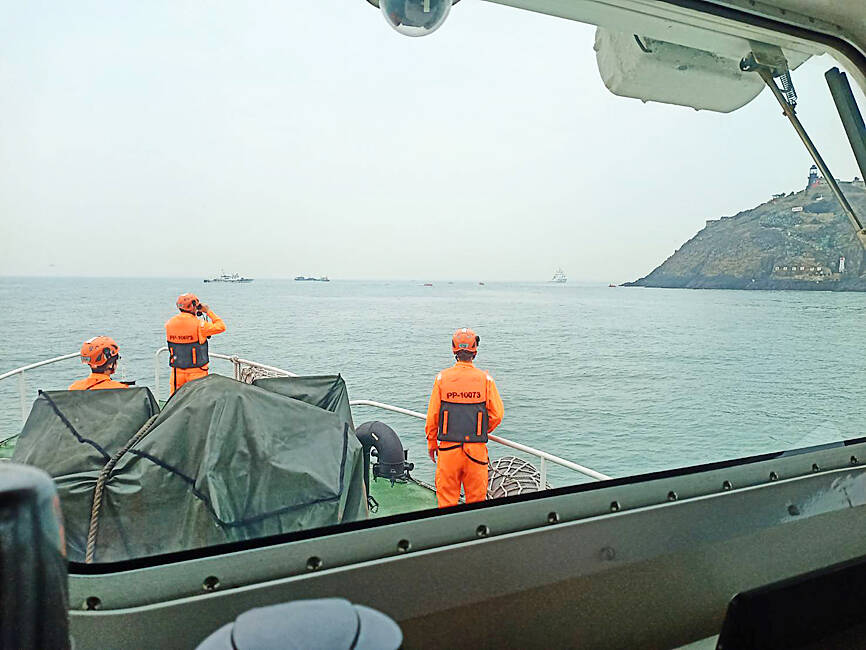The Coast Guard Administration (CGA) was yesterday working with Chinese rescuers to find two missing crewmembers from a Chinese fishing boat that sank southwest of Kinmen County yesterday, killing two crew.
The joint operation managed to rescue two of the boat’s six crewmembers, but two were already dead when they were pulled from the water, the agency said in a statement.
Rescuers are still searching for two others from the Min Long Yu 61222, a boat registered in China’s Fujian Province that capsized and sank 1.03 nautical miles (1.9km) southwest of Dongding Island (東碇), it added.

Photo courtesy of the Coast Guard Administration via CNA
CGA Director-General Chou Mei-wu (周美伍) told a meeting of the legislature’s Foreign Affairs and National Defense Committee that the boat sank about 555m inside Taiwan’s “prohibited waters,” an area in which coast guard vessels are authorized to control the activity of foreign vessels.
Both sides were striving to locate the missing crew within the “golden rescue time” of 72 hours, Chou added.
Four boats from the Ninth (Kinmen) Maritime Patrol along with six helicopters and three vessels from China were conducting a joint search within a 37km radius of where the boat capsized, the CGA said.
The four ships were dispatched after a request for assistance was received from the China Maritime Safety Administration shortly after 6am, it said.
Taiwanese authorities have not publicly commented on the cause of the boat’s capsizing at press time last night.
Sources with knowledge of the matter said that two of the crewmembers remained missing.
The Ministry of National Defense said it had asked the air force’s Combat Command, the navy’s Fleet Command and the army’s Kinmen Defense Command to keep monitoring the situation.
Ocean Affairs Council Minister Kuan Bi-ling (管碧玲) said that the two sides were working closely to rescue the crew of the lost vessel and were maintaining good communication.
“China has shown respect for the proper procedures and we are facilitating this process out of humanitarian concerns,” she said. “China’s coast guard displayed goodwill by avoiding [our] waters and we urge the public to avoid forming misunderstandings.”
China’s Taiwan Affairs Office said it requested the help of Taiwan’s Chinese Search and Rescue Association after the boat ran into a reef off Dongding Island at about 2am.
Chinese rescue teams had taken surviving crewmembers and the bodies of the dead back, the Mainland Affairs Council said, adding that no demand for compensation was filed on the families’ behalf.
Premier Chen Chien-jen (陳建仁) praised the rescue operation, saying previous efforts “have shown that China and Taiwan can work together in humanitarian aid.”
Chou also recalled several previous joint rescue efforts by Taiwanese and Chinese authorities.
“In the past three years, we have had 17 cases like this where they [China] asked us for support, and we rescued 119 people,” he said.
Such cooperation between the two sides is common and close, but Taiwan has always adopted a policy of “rescue those in distress, and expel or ban those who violate the law,” Democratic Progressive Party Legislator Wang Ting-yu (王定宇) wrote on Facebook.
However, politicizing normal responses to illegal movement by unregistered and unflagged boats in a nation’s territorial waters should be condemned, he added.
From July 2016 to November last year, Taiwan penalized nearly 20 Chinese dredgers, confiscated 16 boats and more than 25,000 tonnes of illegally dredged sand, and chased away more than 9,100 boats from its waters, CGA data showed.
Separately, Kuan on Wednesday apologized for the CGA’s shortcomings in collecting evidence during a fatal boat chase off Kinmen last month, which left two Chinese nationals dead.
Amid public criticism of the council’s handling of the case on Feb. 14, Kuan told lawmakers that inadequate evidence collection had resulted in public concern and emotional distress for the affected families.
The council has directed the CGA to establish a committee to conduct a thorough review aimed at enhancing duty management, equipment installation and evidence collection, among others, she said.
Additional reporting by Hung Ting-hung and AFP

The US government has signed defense cooperation agreements with Japan and the Philippines to boost the deterrence capabilities of countries in the first island chain, a report by the National Security Bureau (NSB) showed. The main countries on the first island chain include the two nations and Taiwan. The bureau is to present the report at a meeting of the legislature’s Foreign Affairs and National Defense Committee tomorrow. The US military has deployed Typhon missile systems to Japan’s Yamaguchi Prefecture and Zambales province in the Philippines during their joint military exercises. It has also installed NMESIS anti-ship systems in Japan’s Okinawa

‘WIN-WIN’: The Philippines, and central and eastern European countries are important potential drone cooperation partners, Minister of Foreign Affairs Lin Chia-lung said Minister of Foreign Affairs Lin Chia-lung (林佳龍) in an interview published yesterday confirmed that there are joint ventures between Taiwan and Poland in the drone industry. Lin made the remark in an exclusive interview with the Chinese-language Liberty Times (the Taipei Times’ sister paper). The government-backed Taiwan Excellence Drone International Business Opportunities Alliance and the Polish Chamber of Unmanned Systems on Wednesday last week signed a memorandum of understanding in Poland to develop a “non-China” supply chain for drones and work together on key technologies. Asked if Taiwan prioritized Poland among central and eastern European countries in drone collaboration, Lin

Renewed border fighting between Thailand and Cambodia showed no signs of abating yesterday, leaving hundreds of thousands of displaced people in both countries living in strained conditions as more flooded into temporary shelters. Reporters on the Thai side of the border heard sounds of outgoing, indirect fire yesterday. About 400,000 people have been evacuated from affected areas in Thailand and about 700 schools closed while fighting was ongoing in four border provinces, said Thai Rear Admiral Surasant Kongsiri, a spokesman for the military. Cambodia evacuated more than 127,000 villagers and closed hundreds of schools, the Thai Ministry of Defense said. Thailand’s military announced that

CABINET APPROVAL: People seeking assisted reproduction must be assessed to determine whether they would be adequate parents, the planned changes say Proposed amendments to the Assisted Reproduction Act (人工生殖法) advanced yesterday by the Executive Yuan would grant married lesbian couples and single women access to legal assisted reproductive services. The proposed revisions are “based on the fundamental principle of respecting women’s reproductive autonomy,” Cabinet spokesperson Michelle Lee (李慧芝) quoted Vice Premier Cheng Li-chiun (鄭麗君), who presided over a Cabinet meeting earlier yesterday, as saying at the briefing. The draft amendment would be submitted to the legislature for review. The Ministry of Health and Welfare, which proposed the amendments, said that experts on children’s rights, gender equality, law and medicine attended cross-disciplinary meetings, adding that